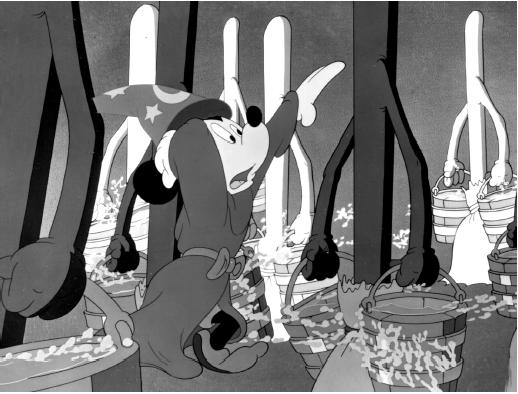 This problem is compounded by the inefficiency of the uranium fuel cycle, that is compounded by the use of enriched uranium in LWR. The problem is simple. The uranium fuel cycle does not efficiently use its nuclear fuel. The fuel cycle produces Pu239, which in a LWR fissions only 2/3 of the time after encountering a neutron, The other 1/3 of the time it becomes Pu240, another problematic isotope. Plutonium is a LWR reactor is a little like the broom in the story of the Sorcerer's Apprentice. Instead of getting rid of plutonium in the LWR, we just keep making more and more, with more and more radiation being the outcome. There are, however Sorcerer reactors, that is reactors that get rid of most and even all of the transuranium isotopes produced by the uranium fuel cycle.
This problem is compounded by the inefficiency of the uranium fuel cycle, that is compounded by the use of enriched uranium in LWR. The problem is simple. The uranium fuel cycle does not efficiently use its nuclear fuel. The fuel cycle produces Pu239, which in a LWR fissions only 2/3 of the time after encountering a neutron, The other 1/3 of the time it becomes Pu240, another problematic isotope. Plutonium is a LWR reactor is a little like the broom in the story of the Sorcerer's Apprentice. Instead of getting rid of plutonium in the LWR, we just keep making more and more, with more and more radiation being the outcome. There are, however Sorcerer reactors, that is reactors that get rid of most and even all of the transuranium isotopes produced by the uranium fuel cycle. The CANDU reactor would be fairly good at that. Within a CANDU reactor, so called "Spent reactor fuel" acts like enriched reactor fuel in a normal reactor. A CANDU reactor will burn what is mistakenly called "High Level Reactor Waste, practically to a cinder. The outcome is mainly fission products and depleted uranium. But this is not good enough. We are still left with undesirable long lived radio active substances in post-CANDU reactor fuel. There is still plutonium. although a whole lot less. Finally, most of the originial energy trapped in U238 is still trapped there in fuel that comes out of the CANDU. Furthermore when the radioactive fission products still trapped in the fuel pellets, eventually became stable and valuable minerals, it will be very expensive to extract them from the ceramic like fuel pellets.
Running supposably spent reactor fuel through a CANDU reactor is an improvement over the one pass approach, but it is far from a solution to the reactor waste issue. Indeed we should not be satisfied with partial solutions.
This table shows that almost all fission products have shore half lives. What it does not show is that most long lived fission products are weak radiation emitters, and several are chemically inactive.

(Click twice to enlarge)
The best "nuclear waste solution would not produce any plutonium, or would channel the plutonium production into uses where it would be valuable. For example, the thorium fuel cycle produces a small amount of Neptunium 237. If Np237 is left in a reactor, it will be tranasformed by a neutron into Pu238, and then Pu239, etc. Pu238 is very valuable because NASA has devised technology to produce electric power from Pu238. The transformation of Np237 into Pu238 is fairly easy in a thorium fuel cycle reactor that uses liquid fuel. The NP237 can be chemically extracted from the fluid coolant/fuel stream, and removed from the reactor, and then bombarded neutrons under controlled conditions.
Thus the production of transuranium nuclear waste can be completely prevented in a liquid thorium fuel cycle reactor, provided that a Np237 is regularly extracted from the reactor. Long lived radioactive fission byproducts include Technetium99, which has a half life of 200,000 years and is a weak beta emitter. Tc99 is chemically active, and it constitutes about 6% of fission byproducts.
Tin126 which has a half life of 230,000 years, and produces a weak beta ray, but then decays into Antimony126 a strong gamma-ray emitter. However Tin126 is a small time player. Very little is produced in the fission process in thermal reactors, and it is chemically inactive.
Selenium-79. present in small amounts as a fission byproduct. Half life reported to be between 65,000 years and 1.13 million years. Se79 is a weak beta emitter.
Zarconium93, which has a half life of one and a half million years, and which produces weak beta emitter, and then decays into Nobium93, a weak gamma emitter.
Caesium 135, yet another low energy beta emitter.
Palladium107, which emits a weak beta emitter, has a half life of 6.5 million years. Palladium is a nobel metal, that does not interact with other chemicals.
Finally we have Iodine-129 which is a weak beta emitter with a reported half life of 15.7 million years. Iodine 129 is chemically active and iodine is concentrated by organisms.
Finally we have Iodine-129 which is a weak beta emitter with a reported half life of 15.7 million years. Iodine 129 is chemically active and iodine is concentrated by organisms.
Solutions: The thorium fuel cycle, if well managed does not produce long lived transuranium isotopes. Long lived fission product radio isotopes are not a threat to the survival of the human species, but the risk involved is their disposal should be taken seriously. Some long lived radio isotopes can be altered into non-radioactive isotopes by neutron bombardment. Other long lived radio-isotopes can be disposed of by glassification and deep burial.









1 comment:
I read through the whole post looking for information on long life fusion products, which I have never heard of before, only to find it was only about fission. The title is wrong.
Post a Comment